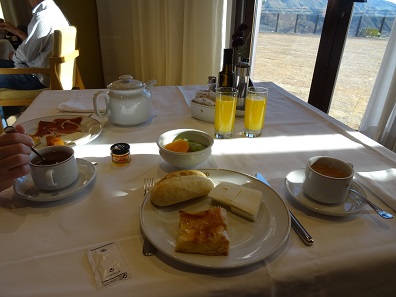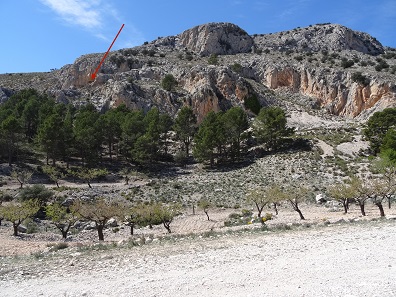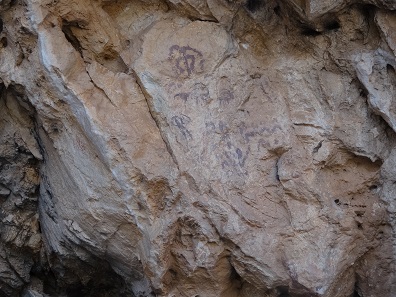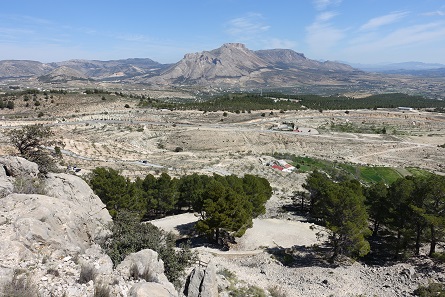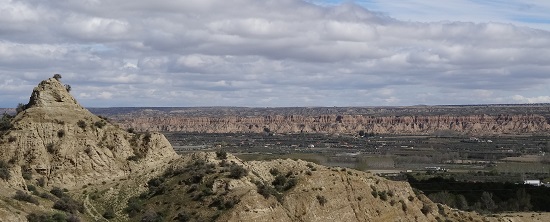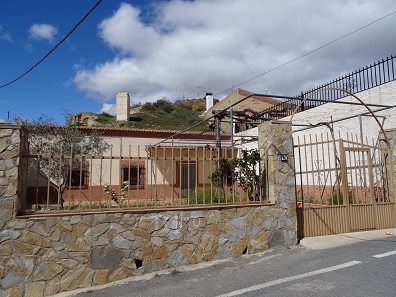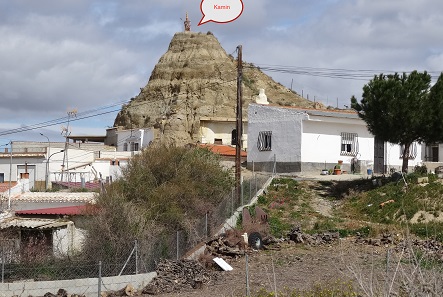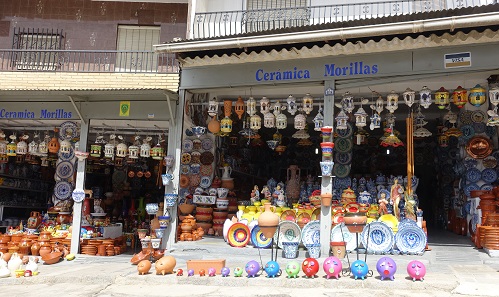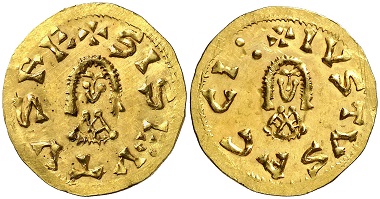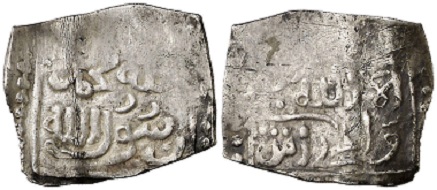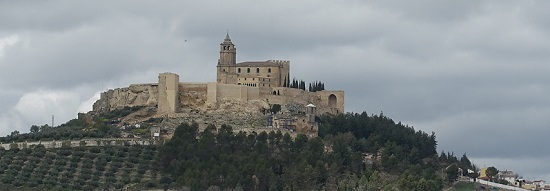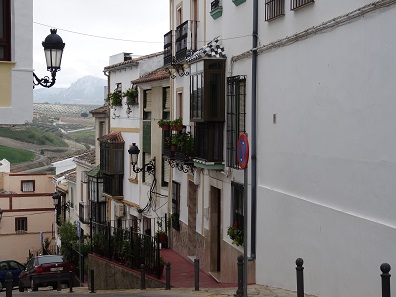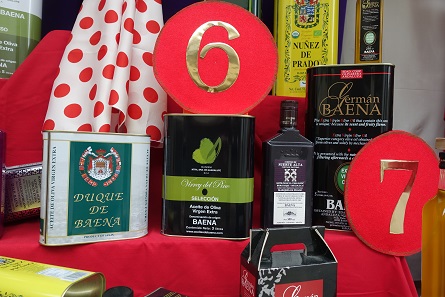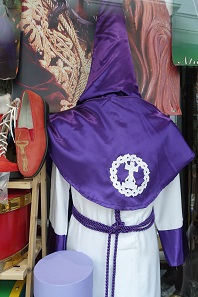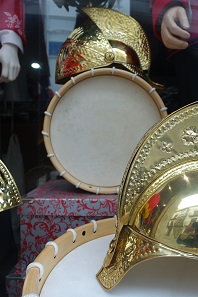by Ursula Kampmann
translated by Teresa Teklic
June 22, 2017 – It’s not just the big highlights which make out the appeal of a country. On the contrary. It’s the many small sights worth seeing and the encounters on the sidelines which make you feel comfortable. In this episode we sail in the lee of Spanish tourism. And I promise you it won’t be any less beautiful!
Breakfast at the parador. Photo: KW.
Sunday, March 26, 2017
Today the clocks are turned back, but all the Spanish families are already at the breakfast tables in spite of that. It’s a hustle and bustle. And I once again find myself admiring the Spanish ability of several people talking at the same time. (Whether they can actually listen to several people at once I haven’t found out yet.)
View onto the Cueva de los Letreros. Photo: KW.
Our destination today is an adventure since there is no information to be found on when the Cueva de los Letreros (= cave of the signs) is open. We would have to announce our visit on the phone, we were told. But I’ve had bad experiences with that. The English of the person on the other end of the line is usually worse than my Spanish. And with my bits and pieces of Spanish I cannot keep up with the locals’ usual rate of speaking. So we just get in our car and drive off. An excellent idea. The cave is well-signposted. Every signpost informs you that the attraction possesses World Heritage Site status. Only the gravel walk, unfortunately rather steep, at the end of the road and the parking lot, rather improvised, engender certain doubts. But we hear voices from far above and see a cordoned-off area. It looks like we actually found the cave.
Ok, maybe not exactly spectacular, but we’re still pleased as a Punch that we are able to visit the abri! Photo: KW.
But when we get to the top, the guide is just about to close the gate after the group he’s given a tour. Luckily he has a big heart. We can immediately convince him to show us the beautiful Neolithic cave paintings, which a few enthusiastic local patriots have declared the Sistine Chapel of the Neolithic Age. Perhaps that’s what they were once upon a time, long before their discovery. But in the meantime the wind and the elements have rendered the largest portion of the valuable paintings invisible. Because this cueva is not a cave in the common meaning of the term but an abri, which, since its discovery in the 19th century, has been exposed to the detrimental effects of the weather and human nature (and its fondness for modifying drawings on public ground).
The emblem of the Almeria province: the indalo.
Still, you can clearly identify the tiny goats, which are being protected by the iconic shepherd and his stylized bow. (I for one think that it looks more like the Neolithic version of a paraglider.)
The high priest with his horned headgear and the large scythes in his hand, on the other hand, has disappeared entirely. Our guide Daniel comforts us by reassuring us that the contours would be much more clearly visible on the many photos that we’re taking. (Which they aren’t, as we realize at home.)
The cave people had a first-class view. Photo: KW.
We leave the area and are super happy that we’ve managed to get into the cave. Daniel tells us that the only tour is once a week, on Sunday, 12 o’clock sharp. He’d made an exception and taken us on an additional tour, but the others who are panting their way up the steep stairs will have to go home empty-handed. Haha. I guess there is a reason why the English use a German word to describe schadenfreude. It simply is the purest form of joy 😉
Afterwards we wanted to go to the seaside. To get there we picked a small road which would lead us to our destination in 33 km. What we didn’t factor in was that there is a sierra, a small mountain range, between the cave and the sea. It didn’t lead us to gigantic heights but through 10,000 bends and a beautiful landscape! That’s what Spain feels like. A farmer’s wife waves to us and I’m sort of expecting Don Quixote to jump out from behind the next bush and start fighting with our car.
How different things are when we get to the coast! The route is described as particularly scenic on the map. And I’m sure it was, 20, 30 years ago. Today it’s blocked up with lots of concrete buildings. Oh, let’s not talk about it!
Monday, March 27, 2017
Today is a really exhausting travel day. We leave our parador in Lorca to drive to Cordoba. If you happen to look at the map and wonder why we don’t do Granada first, let me tell you that the parador in Granada needs to be booked months in advance. Which I did. It’s just that I slightly miscalculated the date. We have a week left before our reservation. Hence the awkward route…
No, you’re not looking at Turkish Göreme but at the Spanish city Guadix, which currently still features around 2,000 inhabited caves. Photo: KW.
So the next four nights we stay in Cordoba. Getting there requires a 400km drive, and not just on highways! Suddenly our eyes fly open in surprise. We believe to be in Göreme, in Turkey. Tuff mountains everywhere. And a sign points out troglodytes, cave dwellers! Of course we make a stop here and get off at the next exit. The place goes by the pretty name of Purullena.
Everyday cave dweller in Purullena. This normal-looking house has a few rooms in the tuff. Photo: KW.
We find houses which are actually largely caves. Only that they’re covered up by house fronts.
People live in this hill. Photo: KW.
It looks funny if you see a chimney stick out from one of the many hills.
Ceramics from Purullena is sold all over Spain. For a higher price than in Purullena. Photo: KW.
And then we pass by many colourful sales stalls and learn that Purullena and Guadix are home to Spanish ceramics production. What costs you dear money in Granada and Cordoba, costs next to nothing here. We stock up on piggy banks for 2 euros each – after all, you can never have too many piggy banks! Especially considering the high interest that you get on your money at the banks right now.
Acci (= Guadix). Tiberius. As. From Aureo & Calico auction sale 290 (2017), No. 10.
Guadix, which was mentioned already by Pliny in his Natural History and by geographer Ptolemy is right around the corner. It even had a mint which manufactured coins, and not too few!
Visigoths. Sisebut (612-621). Acci (= Guadix). Triens. From Aureo & Calico auction sale 271 (2015), 2242.
According to tradition an important bishopric is said to have existed here in Visigoth times, thanks to Saint Torquatus of Acci. The relics of the saint, by the way, were discovered during the Moorish conquest of southern Spain of all times and rolled out to Galicia, where they remained until triumphantly returned in 1592. Well, people need symbols I guess. Whether real or invented seems to be of rather secondary importance.
Guadix. Granada Nasrids. 1/2 dirhem. From Aureo & Calico auction sale 266 (2015), No. 1055.
The city’s modern name, Guadix, comes from Arabic. There was a major centre of silk production here under Moorish rule.
Somewhere on the way to Cordoba. Notice the olive trees neatly lined up next to each other. The ugly new buildings in the foreground have been removed, thanks to Photoshop. Photo: KW.
After Guadix we turn onto a country road and follow a beautiful route along seemingly endless olive groves. I have never seen so many olive trees, neither in Greece nor in Italy. Square kilometre after square kilometre nothing but olive trees! And oil mills, which sell small quantities of oil, every 5 kilometres. Though small is relative. I for my part have no idea what to do with a five-litre can of olive oil…
Baena is picturesque but missing for the cherry on top is a blue sky. Photo: KW.
Shortly after 3.00 pm we reach Baena, which is not only coloured in yellow on our map but also framed in black. Meaning, it’s a small, picturesque city according to our map. Unfortunately the sky is pretty grey and it has started raining, which slightly diminishes the picturesque-ness. Plus, our appetite for something real is greater than that for art right now. The road signs do an exemplary job guiding us to the car park in the Centro Monumental. We park our car. Then off to the next restaurant. If there only was an open restaurant. During the week, in the early season, when it’s raining, nobody seems to be hungry in Baena.
Desperate as I am, I get out my best rudimentary Spanish and ask a Spanish passer-by where we could find something to eat. She beams at me and says that she’ll lead us there since it’s hard to find otherwise. Briefly, I am proud of my Spanish. And then we walk, and walk, and walk. It’s raining and the lady insists I walk under her umbrella. A little bit tricky since she reaches up to my armpits, at best. So we both get wet, despite the umbrella, and we find it’s just wonderful.
Not 15 minutes later we are arrive at the very place where we turned off the main street. It’s where the only open restaurant is located. Our Spanish guide takes leave with a few affectionate hugs (Kurt also gets one), wishes us a safe trip, and off she goes.
Baena is famous for its olive oil. Photo: KW.
It is, by the way, not just the only open but also an excellent restaurant. The jefe brings the menu with English, French, and even German (!) translations. I still choose to read the Spanish version because that’s more comprehensible than the mutilated Google-Translate versions. I order: orange salad, croquettes à la maison, and churrasco. And 5 minutes later a tortilla is placed on our table. I think that my Spanish is apparently not that good after all. I’m intrigued by what I ordered. But it tastes good. I only start to be sceptical when the next dish arrives another short 5 minutes later, broad beans with a fried egg on top. And here comes the jefe. His waiter put the dishes down at the wrong table. First he looks a bit funny because we are eating the tortilla, but then we all have a good laugh. He pats me on the back and concludes that it’s not a big deal. To the kitchen he calls something that I interpret as “another tortilla.”
After we’ve eaten we argue because I want to pay for the tortilla. (Because it was delicious and we’re certainly going to order it again.) The jefe says no way, it was his fault. Who comes out of this as the winner is the waiter, who returns to our table twice to ask whether we’d made a mistake with the tip.
Advertising for the Semana Santa. Photo: KW.
On our way back to the car we notice how pretty this Baena is, although of course it had been much prettier had anything been open.
The things you need, naturally. From a cape… Photo: KW.
So we admire shop windows which display anything that a real Spaniard needs for the Semana Santa: drums and panaches, capes and Roman helmets.
… to a pseudo-Roman helmet. Photo: KW.
And then we face today’s challenge: How do we get from the car park out of the city? It really is a challenge. We drive lap after lap, through the narrowest of streets, which are, on top of things, fully parked left and right. Of course there are streets which go down every now and then, but then those look more like pedestrian walks so that you expect stairs every moment. Finally we spot a bus station, and if a bus can drive there, we can, too – so we think. And it works, somehow.
Only after we’re back on a proper road a few kilometres after Baena, we realize, with a look in the rear-view mirror, the extent of the street entanglement, which reaches almost Arabic dimensions. A real tourist trap: Countless signs lead into the city. If you want to leave it again, however, you’re on your own.
At 6.00 pm we arrive in Cordoba, tired. The parador rises really high above the old town. Though at a distance of a few kilometres. Be that as it may, I still try to book us a room for our next destination that night. Not an easy thing to do. Everybody in Spain seems to be heading to the coast on the weekend. The hotels ask for exorbitant prices. After endless phone calls I still manage to find us a room in Algeciras. But that’s a long way off. For now we look forward to our time in Cordoba.
In our next episode we visit Cordoba. Like myriads of other tourists we visit the Mezquita and forgo the chance to run across the Roman bridge with a bunch of other people. We discover a great numismatic exhibition in the archaeological museum and meet a painter who has designed several Spanish banknotes. Last but not least, we pay our respects to El Cordobes.
You can find all episodes of the numismatic travelogue “To Spain!” here.




